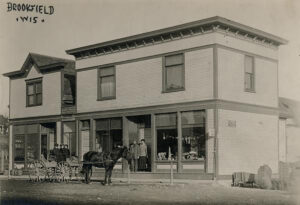About Brookfield
The information below was of Brookfield website repruduced from the City
History
Brookfield, though relatively young as an incorporated municipality, has roots which stretch far back in Wisconsin history. The area around the present City, originally home to the Sac and Potowatomi tribes, was at first ruled by the French. The area came under English control in 1763 after the French and Indian War. After the American Revolution, England ceded its claim to the territory to the United States and the Brookfield area became part the Northwest Territory. Over the years, as new states entered the Union, southeastern Wisconsin was attached to various territories. In 1836, the Brookfield area became part of Milwaukee County in the Territory of Wisconsin.
First Settlement
The first white settler, William Howe, arrived in 1820 with a Presidential Land Grant giving him title to the area. Robert Curran bought a claim in 1836, and established a tavern and inn. By 1839, the population necessitated a school house, and the 1840 census showed a population of 148. In 1846, Milwaukee County was split up into 10 smaller counties. The new County of Waukesha contained 16 townships, including the Town of Brookfield. In 1850, the Milwaukee and Mississippi Railroad (now the Canadian Pacific Rail) built a railroad through the town. The railroad erected a depot in 1853, creating the Brookfield Junction. In 1850, the Town of Brookfield covered 36 square miles and numbered 1,944 inhabitants. The town grew relatively slowly over the ensuing years, remaining primarily agricultural, with Brookfield Junction serving as a commercial center for the surrounding farms. A second railroad depot, constructed in 1867, still stands.
 Between 1850 and World War II, the character of the Town of Brookfield changed little. Brookfield remained a quiet agricultural community. This quiet, rural atmosphere attracted one notorious resident as Al Capone established a residence and distillery on Brookfield Road. The 1920’s also brought the first suburban development to Brookfield. Kinsey’s Garvendale, a residential subdivision, was platted in 1928 in the southeast corner of the Town. The location was chosen to be convenient to the industrial areas in nearby West Allis. The great depression, which started a year later, effectively killed the demand for new housing, and the early subdivisions developed slowly.
Between 1850 and World War II, the character of the Town of Brookfield changed little. Brookfield remained a quiet agricultural community. This quiet, rural atmosphere attracted one notorious resident as Al Capone established a residence and distillery on Brookfield Road. The 1920’s also brought the first suburban development to Brookfield. Kinsey’s Garvendale, a residential subdivision, was platted in 1928 in the southeast corner of the Town. The location was chosen to be convenient to the industrial areas in nearby West Allis. The great depression, which started a year later, effectively killed the demand for new housing, and the early subdivisions developed slowly.
Post World War II
After World War II, development in Brookfield began to increase. A lack of housing, the baby boom, and Government sponsored building programs helped encourage suburban development. After several annexations of Town land by neighboring communities, an incorporation drive started. The City of Brookfield was incorporated August 14, 1954. Franklin Wirth served as the first Mayor. The new city covered an area of 17.5 square miles and had a population of 7,900. At the time, much of the land was still in agricultural use. The City’s founders set out to build a community with a strong industrial and commercial base by encouraging orderly development of office and industrial areas.
Brookfield Today
Today, Brookfield covers almost 27 square miles, numbers over 40,000 residents, and is a major business, retail, and industrial hub in southeastern Wisconsin. Brookfield remains committed to orderly development, responsible government, and maintaining a high quality of life.
Timeline (from the Waukesha County Historical Society & Museum)
1836 First European settler, George Putney, arrived.
1843 First organized church establsihed, St. Dominic’s Catholic Church.
1843 First Methodist church established.
1851 The Milwaukee and Mississippi railroad arrived.
1854 The Milwaukee, Watertown and Baraboo railroads arrived.
1850s Brookfield Junction shopping Center esptablished with hotels, shops, a sawmill and post office.
1867 The current railroad depot was built.
1954 Brookfield incorporated as a city.
1960 City Hall erected.
1967 Brookfield Square opened as one of the biggest shopping centers in Wisconsin.
